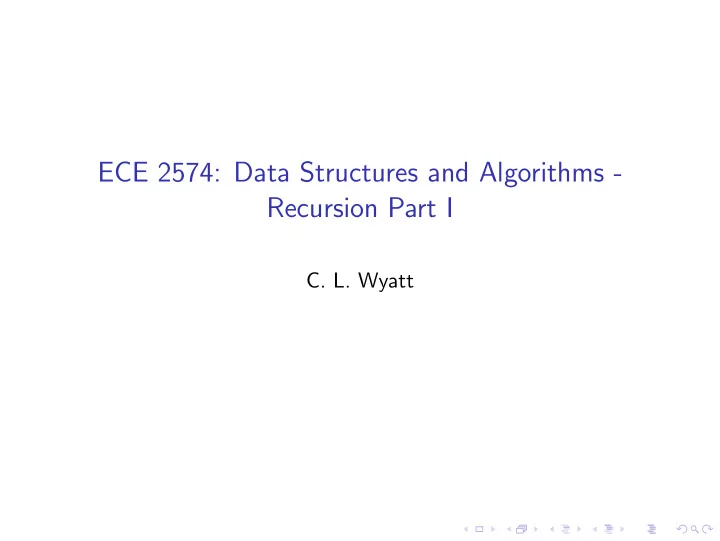

ECE 2574: Data Structures and Algorithms - Recursion Part I C. L. Wyatt
Today we will introduce the notion of recursion, look at some examples, and see how to implement them in code. ◮ Introduction to recursion ◮ Warmup ◮ Examples ◮ Exercise: Recursive Egyptian Powers
Top-down Design Top down design divides problems into smaller and easier sub-problems. The hope is, at each of these successive levels, these sub-problems are easier to solve.
Recursion In some cases, the solution to lowest level sub-problem can be applied at the higher level. This type of solution is called recursive .
A graphical view Graphical depictions of algorithms show connected boxes.
Recursive solutions form nested boxes. ◮ The inner-most box solves the lowest-level problem, ◮ The next box solves the next level above. ◮ In a recursive solution the algorithm is the same at each level.
Example: n!, the factorial Simple iterative solution to compute the factorial int factorial (int n) { int result = n; do { n -= 1; result = result*n; } while (n > 1); return result; }; How large an n will this work for in a real programming languages?
We can break the factorial solution into a recursive solution. n! = 1*2*3*4*......*n grouping terms n! = 1*2*3*4*.......*(n -1)*n n! = ( (n -1)! )*n This is an example of a recurrence relation.
A recursive solution to the factorial int factorial (int n) { if (n <= 1) return 1; else return(n*factorial(n-1)); };
A recursive solution to the factorial Graphically each box takes the output of the box inside it and multiplies by the integer in that box. Example: 4! = 4*3*2*1 = (4*(3*(2*(1))))
Formal definition of recursion ◮ A recursive procedure is one whose evaluation at (non-initial) inputs involves invoking the procedure itself at another input. ◮ In the case of the factorial this involves invoking the procedure at (n-1) when the input is n: n! = n*(n-1)! ◮ Recursion is a very powerful tool in the design and analysis of algorithms. ◮ Often complex problems have very simple recursive solutions.
What makes recursive procedures work ? * At each invocation, the solution must get closer to a known solution i.e. 0! = 1! = 1 ◮ The procedure calls must terminate in a finite number, that is the function must not endlessly call itself. Otherwise the recursion is infinite
Recursive version of the GCD algorithm Recall the GCD algorithm ◮ A.0 If m < n, swap m and n. ◮ A.1 Divide m by n and let r be the remainder. ◮ A.2 If r = 0, terminate; n is the answer. ◮ A.3 Set m to n, n to r, and go back to step A.1. A recursive solution (after step 0). int gcd(int m, int n) { if( n == 0 ) return m; else return gcd(n, m%n); }
Recursive version of the GCD algorithm The recurrence relation for GCD gcd(m,n) = gcd(n, m mod n) The stopping condition (base case) is n = 0 Example: gcd(131,62) -> gcd(62,7) -> gcd(7,6) -> gcd (6,1) -> gcd(1,0)
Warmup #1 Which of the following C++ functions correctly computes the sum from 1 to n using recursion? int function1(int n){ int sum = 0; for(int i = 1; i <= n; ++i){ sum += i; } return sum; } Incorrect. (15%).
Warmup #1 Which of the following C++ functions correctly computes the sum from 1 to n using recursion? int function2(int n){ if(n == 1) return 1; return n + function2(n-1); } Correct (81%).
Warmup #1 Which of the following C++ functions correctly computes the sum from 1 to n using recursion? int function3(int n){ return n*(n+1)/2; } Incorrect. (3%).
Warmup #2 What would happen if function1 in the previous question was called with an argument of -1? int function1(int n){ int sum = 0; for(int i = 1; i <= n; ++i){ sum += i; } return sum; } The correct answer is “it would return 0” (63%).
Warmup #3 What would happen if function2 in the previous question was called with an argument of -1? int function2(int n){ if(n == 1) return 1; return n + function2(n-1); } The correct answer is “A run-time error would occur” (73%).
Warmup #4 What would happen if function3 in the previous question was called with an argument of -1? int function3(int n){ return n*(n+1)/2; } The correct answer is “It would return 0” (85%).
Another Example: Exponentiation ◮ The Egyptian Powers algorithm computes x to the power n by repeated squaring. ◮ The recurrence relation for computing x n for any positive integer n: ( x · x ) n / 2 � n even x n = x ( x · x ) ( n − 1) / 2 n odd
Exercise: write a recursive function and a set of tests implementing the Egyptian Powers algorithm. In pseudo-code function RecPowers (x, n) Input: a real number x and positive integer n Output: x raised to power n if (n == 1) // initial condition pow = x; else if even(n) then pow = RecPowers(x*x,n/2) else pow = x*RecPowers(x*x,(n-1)/2) endif endif return (pow) endfunction
Next Actions and Reminders ◮ Read CH pp. 67-87 ◮ Warmup before noon on Monday. ◮ Program 0 due tonight by 11:59 PM.
Recommend
More recommend